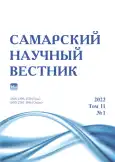Методика проведения практических занятий по ботанике в условиях дистанционного обучения в период пандемии COVID-19
- Авторы: Токарь О.Е.1
-
Учреждения:
- Тюменский государственный университет
- Выпуск: Том 11, № 1 (2022)
- Страницы: 325-331
- Раздел: Педагогические науки
- URL: https://journals.rcsi.science/2309-4370/article/view/108365
- DOI: https://doi.org/10.55355/snv2022111311
- ID: 108365
Цитировать
Полный текст
Аннотация
Вынужденный экстренный повсеместный переход в период пандемии COVID-19 на дистанционное обучение потребовал срочного освоения новых инструментов для работы в цифровой среде, адаптации к новым способам коммуникации в системе преподаватель–студент. Использование цифровых инструментов и технологий при реализации подготовки бакалавра в контексте цифровизации высшего образования и внедрение онлайн-образования усложнило деятельность преподавателя по проектированию процесса обучения; в частности, трудности связаны с отсутствием исследований, посвященных изучению и описанию практики обучения биологии, в том числе ботаники, в онлайн-формате, методических разработок для организации таких форм работы со студентами, как практическая работа. В связи с возникшей ситуацией необходим был поиск новых путей реализации различных видов деятельности в дистанционном формате, поиск новых способов коммуникации в системе преподаватель–студент, апробирование современных педагогических технологий. Во многих вузах, в том числе и в Ишиме, начиная с осени 2020 г. стали успешно использовать платформу Microsoft Teams. При проведении исследования были использованы методы: теоретический и сравнительный анализ литературы, систематизация и обобщение, сбор и оценивание результатов выполненных заданий (отчетов по работе с кейсами, результатов тестирования и анкетирования). Результаты выполнения индивидуального задания – отчета по работе с кейс-иллюстрацией – показали, что 47% студентов получили оценку «удовлетворительно», 53% – оценку «хорошо». Качественная успеваемость по результатам тестирования составила 53%. Результаты проведенного анкетирования «Рефлексивный экран» позволили выявить положительный эффект, полученный от занятия, проведенного в онлайн-формате (100% обучающихся было интересно на занятии). В статье подробно описана методика проведения одного из практических онлайн-занятий по ботанике, проведенного в дистанционном формате зимой 2021 г., и сделан его анализ.
Полный текст
Открыть статью на сайте журналаОб авторах
Ольга Егоровна Токарь
Тюменский государственный университет
Автор, ответственный за переписку.
Email: tokarishim@yandex.ru
кандидат биологических наук, доцент кафедры биологии, географии и методики их преподавания
Россия, ТюменьСписок литературы
- Favale T., Soro F., Trevisan M., Drago I., Mellia M. Campus traffic and e-Learning during COVID-19 pandemic // Computer Networks. 2020. Vol. 176. doi: 10.1016/j.comnet.2020.107290.
- Об организации образовательной деятельности в организациях, реализующих образовательные программы высшего образования и соответствующие дополнительные профессиональные программы, в условиях предупреждения распространения новой коронавирусной инфекции на территории Российской Федерации: приказ Министерства науки и высшего образования РФ от 14.03.2020 № 397 [Электронный ресурс] // Информационно-правовой портал «Гарант.ру». https://www.garant.ru/products/ipo/prime/doc/73645128.
- Пучкова Е.Б., Темнова Л.В., Сорокоумова Е.А., Чердымова Е.И. Готовность преподавателей вузов к дистанционной работе в период пандемии COVID-19 // Перспективы науки и образования. 2020. № 6 (48). С. 89-102. doi: 10.32744/pse.2020.6.8.
- Бибалова С.А., Леонтьева А.В. Анализ перехода на дистанционное обучение в системе вузовской подготовки в период пандемии (на примере ФГБОУ ВО «Майкопский государственный технологический университет» и ФГБОУ ВО «Адыгейский государственный университет») // Вестник Майкопского государственного технологического университета. 2021. Т. 13, № 4. С. 59-68.
- Баранова И.И., Виноградова М.В., Доценко М.Ю. Особенности дистанционного обучения русскому языку иностранных учащихся в современных условиях российского вуза // Перспективы науки и образования. 2020. № 6 (48). С. 204-219. doi: 10.32744/pse.2020.6.16.
- Ana A., Minghat A.D., Purnawarman P., Saripudin S., Muktiarni M., Dwiyanti V., Mustakim SS. Students' perceptions of the twists and turns of e-learning in the midst of the COVID 19 outbreak // Revista Romaneasca Pentru Educatie Multidimensionala. 2020. Vol. 12, № 1. P. 15-26. doi: 10.18662/rrem/12.1sup2/242.
- Неборский Е.В., Богуславский М.В., Ладыжец Н.С., Наумова Т.А., Анисимов А.Е. Переход на дистанционное обучение в условиях COVID-19 в оценках профессорско-преподавательского состава // Перспективы науки и образования. 2020. № 4 (46). С. 99-110. doi: 10.32744/pse.2020.4.6.
- Нетребко Е.Н., Хлабыстова Н.В. Дистанционное обучение в период пандемии COVID-19: на материалах эмпирического исследования // Вестник Адыгейского государственного университета. Серия 1: Регионоведение: философия, история, социология, юриспруденция, политология, культурология. 2020. № 4 (269). С. 146-151.
- Остапченко Г.С. Дистанционное обучение в период пандемии: проблемы и возможные риски // Теория и практика общественного развития. 2021. № 5 (159). С. 28-30.
- Фролова Е.В., Рогач О.В., Рябова Т.М. Преимущества и риски перехода на дистанционное обучение в условиях пандемии // Перспективы науки и образования. 2020. № 6 (48). С. 78-88. doi: 10.32744/pse.2020.6.7.
- McGovern E., Moreira G., Luna-Nevarez C. An application of virtual reality in education: can this technology enhance the quality of students' learning experience? // Journal of Education for Business. 2020. Vol. 95, iss. 7. P. 490-496. doi: 10.1080/08832323.2019.1703096.
- Попельницкая И.М., Шилина Н.Г., Попельницкий Е.В., Почекутов С.И., Геращенко С.М., Бухаров А.В. Дистанционное обучение в период пандемии COVID-19 глазами студентов Красноярска // Современные проблемы науки и образования. 2021. № 6. doi: 10.17513/spno.31386.
- Пилилян Н.Ю. Анализ использования современных образовательных технологий в образовательном учреждении, работающем в дистанционном режиме // Вопросы педагогики. 2020. № 6-2. С. 195-198.
- Старчикова И.Ю. Особенности дистанционного обучения в современных условиях российского вуза: по материалам опроса студентов // Перспективы науки и образования. 2021. № 2 (50). С. 103-117. doi: 10.32744/pse.2021.2.7.
- Баландин С.А., Абрамова Л.И., Березина Н.А. Общая ботаника с основами геоботаники: учебное пособие. 2-е изд., испр. и доп. М.: ИКЦ «Академкнига», 2006. 293 с.
- Еленевский А.Г., Соловьева М.П., Тихомиров В.Н. Ботаника. Систематика высших, или наземных, растений: учебник. 3-е изд., испр. и доп. М.: Академия, 2000. 432 с.
- Глазунов В.А., Науменко Н.В., Хозяинов Н.В. Определитель сосудистых растений Тюменской области. Тюмень: Проспект, 2017. 744 с.
- Красная книга Тюменской области: Животные, растения, грибы / отв. ред. О.А. Петрова. Изд. 2-е. Кемерово: ООО «Технопринт», 2020. 460 с.
- Плантариум: растения и лишайники России и сопредельных стран: открытый онлайн-атлас и определитель растений [Электронный ресурс] // https://www.plantarium.ru.
Дополнительные файлы







